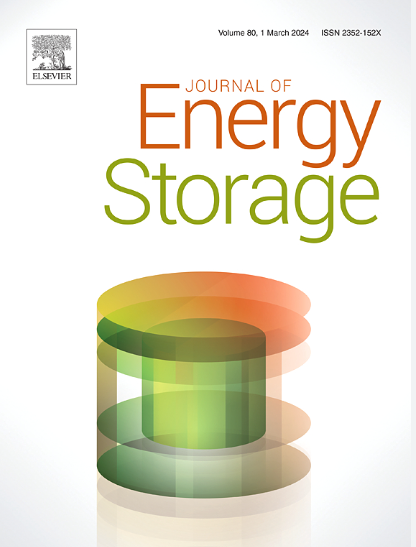用于 pH 值中性水溶液有机氧化还原液流电池的高水溶性吩嗪季铵化合物阴离子溶液
IF 8.9
2区 工程技术
Q1 ENERGY & FUELS
引用次数: 0
摘要
pH 值中性的水氧化还原液流电池(ARFB)与酸性或碱性电解质的液流电池相比,具有无腐蚀性、低成本和更宽的电化学稳定性窗口等优点,是最具吸引力的液流电池之一。然而,很少有有机氧化还原活性分子系列可用作 pH 值中性 ARFB 的阴极溶质材料。在这里,通过在具有氧化还原活性的吩噁嗪核中加入季铵分子,一种有机溶液材料--N, N, N-三甲基-2-(10H-吩噁嗪-10-基)乙烷-1-氯化铵(NEt-POZ)被用于 pH 值中性的 ARFB。NEt-POZ 对 SHE 的氧化还原电位高达 0.79 V,氧化还原动力学速度快(0.23 cm s-1),水溶性高(在 H2O 中为 2.6 M)。然而,长期循环实验结果表明,NEt-POZ 电解质的库仑效率较低,容量迅速下降。机理分析表明,在溶液中通过自由基二阳离子(NEt-POZ2+)歧化形成的不稳定双氧化三阳离子(NEt-POZ3+)很容易与氯阴离子发生反应,形成多氯衍生物,这些衍生物由于水溶性差而从阴极溶液中析出,导致容量迅速下降。当电解质溶液中不存在氯离子时,高活性 NEt-POZ3+ 阳离子可与其他反离子(如硫酸根离子和碳酸根离子)甚至水发生作用,形成复杂的加合物。本文章由计算机程序翻译,如有差异,请以英文原文为准。
A highly water-soluble phenoxazine quaternary ammonium compound catholyte for pH-neutral aqueous organic redox flow batteries
The pH-neutral aqueous redox flow battery (ARFB) is one of the most attractive flow batteries due to its non-corrosiveness, low-cost, and wider electrochemical stability window compared to those with acidic or alkaline electrolytes. However, there are few families of organic redox-active molecules available as catholyte materials for pH-neutral ARFBs. Herein, through incorporation of quaternary ammonium moiety into the redox-active phenoxazine nucleus, an organic catholyte material, N, N, N-trimethyl-2-(10H-phenoxazin-10-yl) ethan-1-aminium chloride (NEt-POZ) is achieved for pH-neutral ARFBs. The NEt-POZ has a high redox potential of 0.79 V versus SHE and rapid redox kinetics (0.23 cm s−1) as well as high water-solubility (∼2.6 M in H2O). Paired with a methyl viologen (MV) anolyte in the pH-neutral aqueous electrolyte, a viologen-phenoxazine ARFB full cell is assembled, which shows an open circuit voltage of ∼1.23 V. However, the results of long-term cycling experiments indicate low Coulomb efficiency and rapid declining capacity of the NEt-POZ catholyte. The mechanism analysis unveils that the unstable doubly oxidized tri-cations (NEt-POZ3+) formed via the disproportionation of radical di-cations (NEt-POZ2+![]() ) in solution readily react with chloride anions to form poly-chlorinated derivatives, which precipitate from the catholyte due to their poor water solubility, leading to a rapid decrease in capacity. When there is no chloride present in the electrolyte solution, highly reactive NEt-POZ3+ cations can interact with other counter-anions (such as sulfate and carbonate ions) and even water to form complex adducts.
) in solution readily react with chloride anions to form poly-chlorinated derivatives, which precipitate from the catholyte due to their poor water solubility, leading to a rapid decrease in capacity. When there is no chloride present in the electrolyte solution, highly reactive NEt-POZ3+ cations can interact with other counter-anions (such as sulfate and carbonate ions) and even water to form complex adducts.
求助全文
通过发布文献求助,成功后即可免费获取论文全文。
去求助
来源期刊

Journal of energy storage
Energy-Renewable Energy, Sustainability and the Environment
CiteScore
11.80
自引率
24.50%
发文量
2262
审稿时长
69 days
期刊介绍:
Journal of energy storage focusses on all aspects of energy storage, in particular systems integration, electric grid integration, modelling and analysis, novel energy storage technologies, sizing and management strategies, business models for operation of storage systems and energy storage developments worldwide.
 求助内容:
求助内容: 应助结果提醒方式:
应助结果提醒方式:


